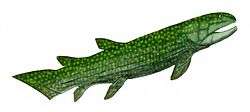Greererpeton
| Greererpeton burkemorani Temporal range: Viséan 345.3–328.3 Ma | |
|---|---|
 | |
| Fossil specimen | |
| Scientific classification | |
| Kingdom: | Animalia |
| Phylum: | Chordata |
| Class: | Sarcopterygii |
| Clade: | Tetrapodomorpha |
| Family: | †Colosteidae |
| Genus: | †Greererpeton |
| Species: | †G. burkemorani |
| Binomial name | |
| Greererpeton burkemorani Romer, 1969 | |
Greererpeton burkemorani ("amphibian from Greer") is an extinct genus of stem-tetrapods from the Early Carboniferous period (late Viséan) of North America.
The greererpeton lived in the Paleozoic era. It was an aquatic tetrapod. Greererpeton had an elongated body adapted for swimming, reaching up to 1.5 metres (4.9 ft) in length, including the tail. It was carnivorous and probably ate mostly fish. Its body had 40 vertebrae, twice the usual amount, and a flattened skull about 18 centimetres (7.1 in) long. The limbs were short, and mainly used for steering, with the long tail providing the main propulsive force while swimming.

Some marks on the side of the skull indicate that Greererpeton had a lateral line, a sensory organ commonly found only in fish. Its ears were also poorly developed. Taken together, these are indications that Greererpeton was a primitive amphibian that had an almost wholly aquatic existence, rarely, if ever, venturing onto dry land.[1]
Greererpeton was a carnivore and probably lived in rivers and swamps.[2]
Footnotes
- ↑ Palmer, D., ed. (1999). The Marshall Illustrated Encyclopedia of Dinosaurs and Prehistoric Animals. London: Marshall Editions. p. 51. ISBN 1-84028-152-9.
- ↑ M. Alan Kazlev (1998) The Carboniferous Period of the Paleozoic Era: 299 to 359 million years ago, Palaeos.org, Retrieved on 2008-06-23
External links
- Greerpeton & Spathicephalus from Palaeos web
- THE MANDIBLE OF THE PRIMITIVE TETRAPOD GREERERPETON by JOHN R. BOLT and R. ERIC LOMBARD
- Skull fossil

